Marketing Plan: Spice Habit - London's Indian Vegetarian Restaurant
VerifiedAdded on 2023/01/05
|10
|3170
|46
Report
AI Summary
This marketing plan outlines the business strategy for Spice Habit, an Indian vegetarian restaurant in London, focusing on a B2C model with penetration pricing initially and premium pricing later. The plan details the restaurant's offerings, including organic and health-conscious Indian cuisine, and its location in Earls Court. It includes a comprehensive market analysis, assessing the external environment through PESTLE analysis and conducting a competitive analysis. A SWOT analysis is also provided to evaluate the restaurant's strengths, weaknesses, opportunities, and threats. The report emphasizes the importance of market gaps, competitive advantages, and strategic marketing approaches, aiming to establish Spice Habit as a successful restaurant business.

Starting a business and
fundamentals of marketing
fundamentals of marketing
Paraphrase This Document
Need a fresh take? Get an instant paraphrase of this document with our AI Paraphraser
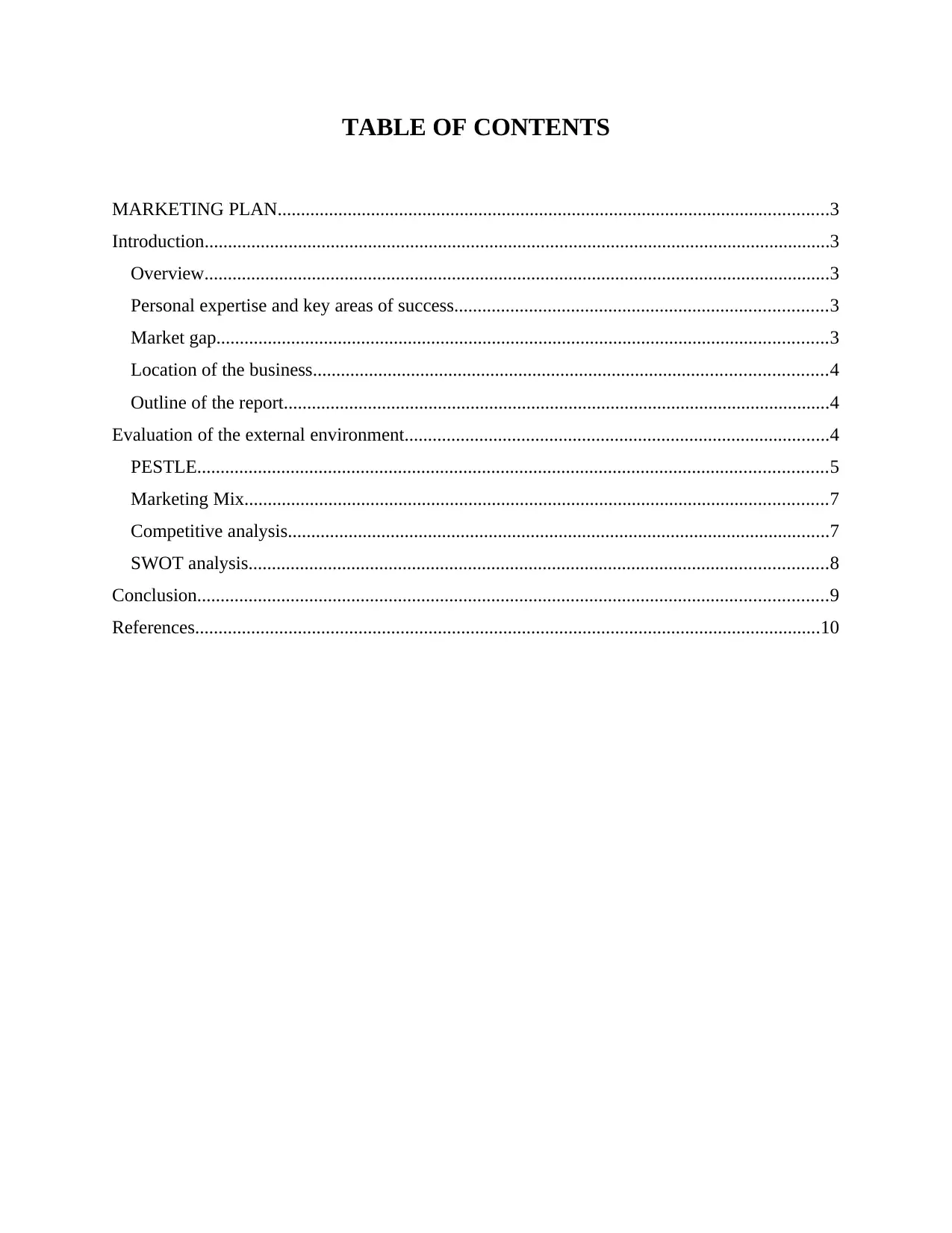
TABLE OF CONTENTS
MARKETING PLAN......................................................................................................................3
Introduction......................................................................................................................................3
Overview......................................................................................................................................3
Personal expertise and key areas of success................................................................................3
Market gap...................................................................................................................................3
Location of the business..............................................................................................................4
Outline of the report.....................................................................................................................4
Evaluation of the external environment...........................................................................................4
PESTLE.......................................................................................................................................5
Marketing Mix.............................................................................................................................7
Competitive analysis....................................................................................................................7
SWOT analysis............................................................................................................................8
Conclusion.......................................................................................................................................9
References......................................................................................................................................10
MARKETING PLAN......................................................................................................................3
Introduction......................................................................................................................................3
Overview......................................................................................................................................3
Personal expertise and key areas of success................................................................................3
Market gap...................................................................................................................................3
Location of the business..............................................................................................................4
Outline of the report.....................................................................................................................4
Evaluation of the external environment...........................................................................................4
PESTLE.......................................................................................................................................5
Marketing Mix.............................................................................................................................7
Competitive analysis....................................................................................................................7
SWOT analysis............................................................................................................................8
Conclusion.......................................................................................................................................9
References......................................................................................................................................10
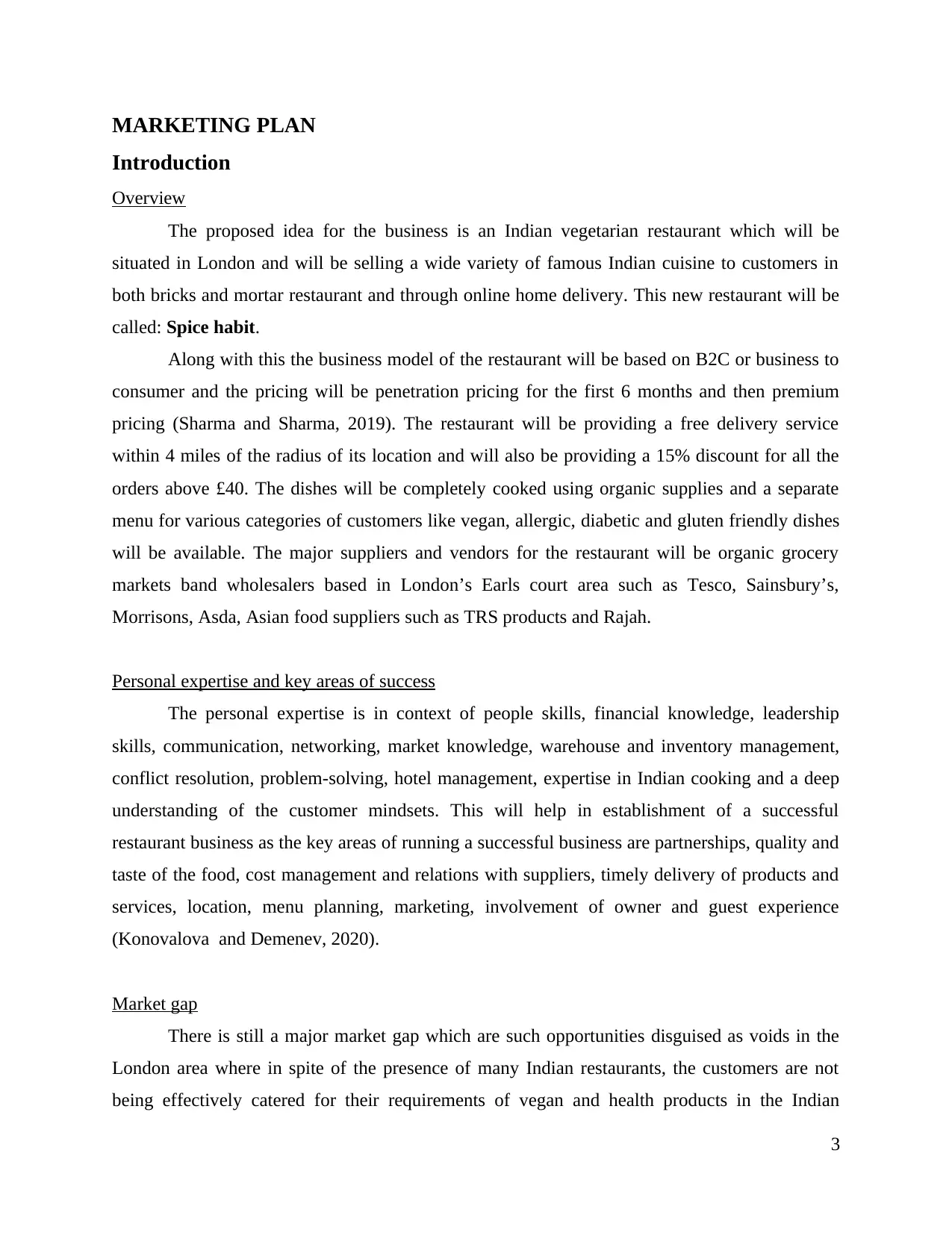
MARKETING PLAN
Introduction
Overview
The proposed idea for the business is an Indian vegetarian restaurant which will be
situated in London and will be selling a wide variety of famous Indian cuisine to customers in
both bricks and mortar restaurant and through online home delivery. This new restaurant will be
called: Spice habit.
Along with this the business model of the restaurant will be based on B2C or business to
consumer and the pricing will be penetration pricing for the first 6 months and then premium
pricing (Sharma and Sharma, 2019). The restaurant will be providing a free delivery service
within 4 miles of the radius of its location and will also be providing a 15% discount for all the
orders above £40. The dishes will be completely cooked using organic supplies and a separate
menu for various categories of customers like vegan, allergic, diabetic and gluten friendly dishes
will be available. The major suppliers and vendors for the restaurant will be organic grocery
markets band wholesalers based in London’s Earls court area such as Tesco, Sainsbury’s,
Morrisons, Asda, Asian food suppliers such as TRS products and Rajah.
Personal expertise and key areas of success
The personal expertise is in context of people skills, financial knowledge, leadership
skills, communication, networking, market knowledge, warehouse and inventory management,
conflict resolution, problem-solving, hotel management, expertise in Indian cooking and a deep
understanding of the customer mindsets. This will help in establishment of a successful
restaurant business as the key areas of running a successful business are partnerships, quality and
taste of the food, cost management and relations with suppliers, timely delivery of products and
services, location, menu planning, marketing, involvement of owner and guest experience
(Konovalova and Demenev, 2020).
Market gap
There is still a major market gap which are such opportunities disguised as voids in the
London area where in spite of the presence of many Indian restaurants, the customers are not
being effectively catered for their requirements of vegan and health products in the Indian
3
Introduction
Overview
The proposed idea for the business is an Indian vegetarian restaurant which will be
situated in London and will be selling a wide variety of famous Indian cuisine to customers in
both bricks and mortar restaurant and through online home delivery. This new restaurant will be
called: Spice habit.
Along with this the business model of the restaurant will be based on B2C or business to
consumer and the pricing will be penetration pricing for the first 6 months and then premium
pricing (Sharma and Sharma, 2019). The restaurant will be providing a free delivery service
within 4 miles of the radius of its location and will also be providing a 15% discount for all the
orders above £40. The dishes will be completely cooked using organic supplies and a separate
menu for various categories of customers like vegan, allergic, diabetic and gluten friendly dishes
will be available. The major suppliers and vendors for the restaurant will be organic grocery
markets band wholesalers based in London’s Earls court area such as Tesco, Sainsbury’s,
Morrisons, Asda, Asian food suppliers such as TRS products and Rajah.
Personal expertise and key areas of success
The personal expertise is in context of people skills, financial knowledge, leadership
skills, communication, networking, market knowledge, warehouse and inventory management,
conflict resolution, problem-solving, hotel management, expertise in Indian cooking and a deep
understanding of the customer mindsets. This will help in establishment of a successful
restaurant business as the key areas of running a successful business are partnerships, quality and
taste of the food, cost management and relations with suppliers, timely delivery of products and
services, location, menu planning, marketing, involvement of owner and guest experience
(Konovalova and Demenev, 2020).
Market gap
There is still a major market gap which are such opportunities disguised as voids in the
London area where in spite of the presence of many Indian restaurants, the customers are not
being effectively catered for their requirements of vegan and health products in the Indian
3
⊘ This is a preview!⊘
Do you want full access?
Subscribe today to unlock all pages.

Trusted by 1+ million students worldwide
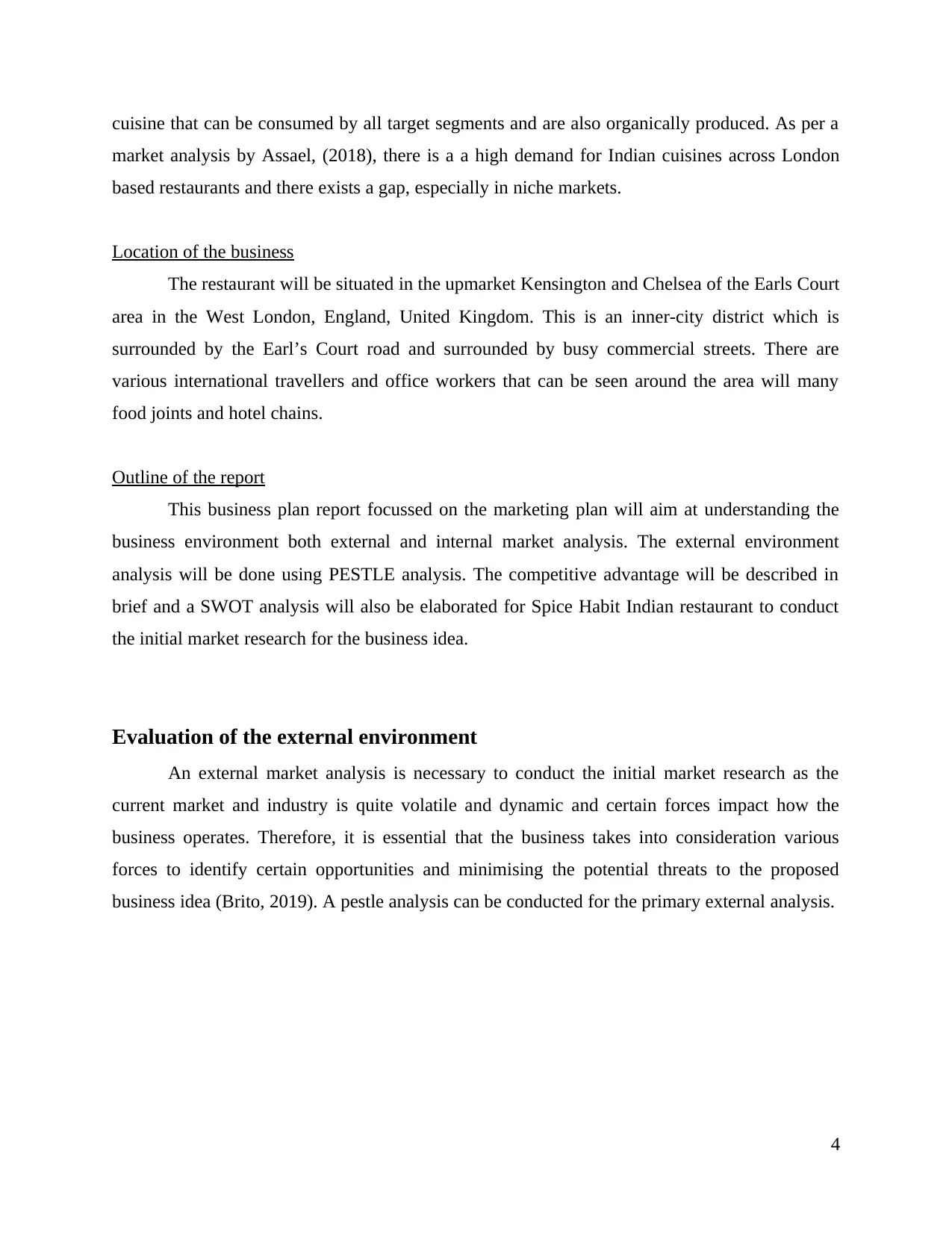
cuisine that can be consumed by all target segments and are also organically produced. As per a
market analysis by Assael, (2018), there is a a high demand for Indian cuisines across London
based restaurants and there exists a gap, especially in niche markets.
Location of the business
The restaurant will be situated in the upmarket Kensington and Chelsea of the Earls Court
area in the West London, England, United Kingdom. This is an inner-city district which is
surrounded by the Earl’s Court road and surrounded by busy commercial streets. There are
various international travellers and office workers that can be seen around the area will many
food joints and hotel chains.
Outline of the report
This business plan report focussed on the marketing plan will aim at understanding the
business environment both external and internal market analysis. The external environment
analysis will be done using PESTLE analysis. The competitive advantage will be described in
brief and a SWOT analysis will also be elaborated for Spice Habit Indian restaurant to conduct
the initial market research for the business idea.
Evaluation of the external environment
An external market analysis is necessary to conduct the initial market research as the
current market and industry is quite volatile and dynamic and certain forces impact how the
business operates. Therefore, it is essential that the business takes into consideration various
forces to identify certain opportunities and minimising the potential threats to the proposed
business idea (Brito, 2019). A pestle analysis can be conducted for the primary external analysis.
4
market analysis by Assael, (2018), there is a a high demand for Indian cuisines across London
based restaurants and there exists a gap, especially in niche markets.
Location of the business
The restaurant will be situated in the upmarket Kensington and Chelsea of the Earls Court
area in the West London, England, United Kingdom. This is an inner-city district which is
surrounded by the Earl’s Court road and surrounded by busy commercial streets. There are
various international travellers and office workers that can be seen around the area will many
food joints and hotel chains.
Outline of the report
This business plan report focussed on the marketing plan will aim at understanding the
business environment both external and internal market analysis. The external environment
analysis will be done using PESTLE analysis. The competitive advantage will be described in
brief and a SWOT analysis will also be elaborated for Spice Habit Indian restaurant to conduct
the initial market research for the business idea.
Evaluation of the external environment
An external market analysis is necessary to conduct the initial market research as the
current market and industry is quite volatile and dynamic and certain forces impact how the
business operates. Therefore, it is essential that the business takes into consideration various
forces to identify certain opportunities and minimising the potential threats to the proposed
business idea (Brito, 2019). A pestle analysis can be conducted for the primary external analysis.
4
Paraphrase This Document
Need a fresh take? Get an instant paraphrase of this document with our AI Paraphraser
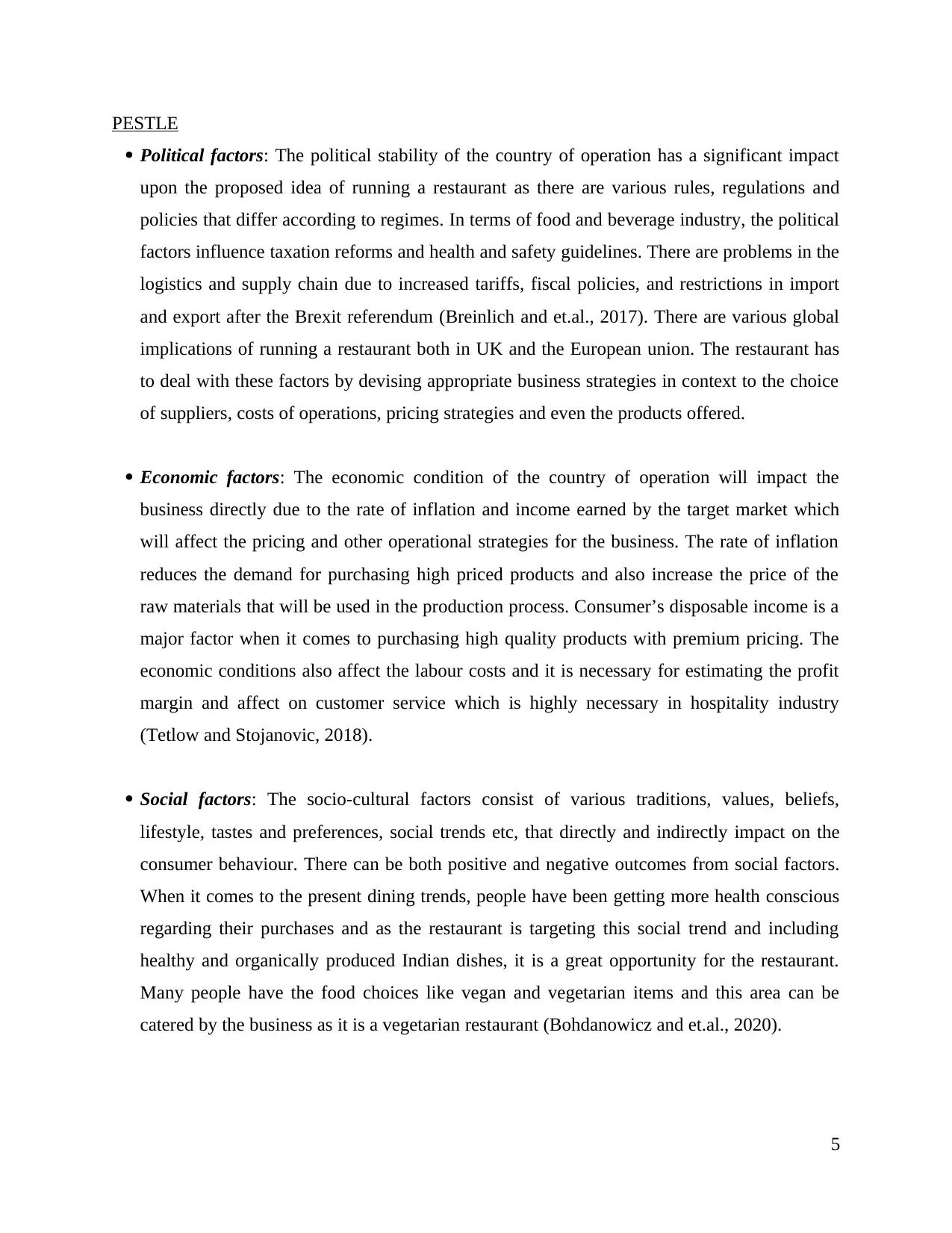
PESTLE
Political factors: The political stability of the country of operation has a significant impact
upon the proposed idea of running a restaurant as there are various rules, regulations and
policies that differ according to regimes. In terms of food and beverage industry, the political
factors influence taxation reforms and health and safety guidelines. There are problems in the
logistics and supply chain due to increased tariffs, fiscal policies, and restrictions in import
and export after the Brexit referendum (Breinlich and et.al., 2017). There are various global
implications of running a restaurant both in UK and the European union. The restaurant has
to deal with these factors by devising appropriate business strategies in context to the choice
of suppliers, costs of operations, pricing strategies and even the products offered.
Economic factors: The economic condition of the country of operation will impact the
business directly due to the rate of inflation and income earned by the target market which
will affect the pricing and other operational strategies for the business. The rate of inflation
reduces the demand for purchasing high priced products and also increase the price of the
raw materials that will be used in the production process. Consumer’s disposable income is a
major factor when it comes to purchasing high quality products with premium pricing. The
economic conditions also affect the labour costs and it is necessary for estimating the profit
margin and affect on customer service which is highly necessary in hospitality industry
(Tetlow and Stojanovic, 2018).
Social factors: The socio-cultural factors consist of various traditions, values, beliefs,
lifestyle, tastes and preferences, social trends etc, that directly and indirectly impact on the
consumer behaviour. There can be both positive and negative outcomes from social factors.
When it comes to the present dining trends, people have been getting more health conscious
regarding their purchases and as the restaurant is targeting this social trend and including
healthy and organically produced Indian dishes, it is a great opportunity for the restaurant.
Many people have the food choices like vegan and vegetarian items and this area can be
catered by the business as it is a vegetarian restaurant (Bohdanowicz and et.al., 2020).
5
Political factors: The political stability of the country of operation has a significant impact
upon the proposed idea of running a restaurant as there are various rules, regulations and
policies that differ according to regimes. In terms of food and beverage industry, the political
factors influence taxation reforms and health and safety guidelines. There are problems in the
logistics and supply chain due to increased tariffs, fiscal policies, and restrictions in import
and export after the Brexit referendum (Breinlich and et.al., 2017). There are various global
implications of running a restaurant both in UK and the European union. The restaurant has
to deal with these factors by devising appropriate business strategies in context to the choice
of suppliers, costs of operations, pricing strategies and even the products offered.
Economic factors: The economic condition of the country of operation will impact the
business directly due to the rate of inflation and income earned by the target market which
will affect the pricing and other operational strategies for the business. The rate of inflation
reduces the demand for purchasing high priced products and also increase the price of the
raw materials that will be used in the production process. Consumer’s disposable income is a
major factor when it comes to purchasing high quality products with premium pricing. The
economic conditions also affect the labour costs and it is necessary for estimating the profit
margin and affect on customer service which is highly necessary in hospitality industry
(Tetlow and Stojanovic, 2018).
Social factors: The socio-cultural factors consist of various traditions, values, beliefs,
lifestyle, tastes and preferences, social trends etc, that directly and indirectly impact on the
consumer behaviour. There can be both positive and negative outcomes from social factors.
When it comes to the present dining trends, people have been getting more health conscious
regarding their purchases and as the restaurant is targeting this social trend and including
healthy and organically produced Indian dishes, it is a great opportunity for the restaurant.
Many people have the food choices like vegan and vegetarian items and this area can be
catered by the business as it is a vegetarian restaurant (Bohdanowicz and et.al., 2020).
5
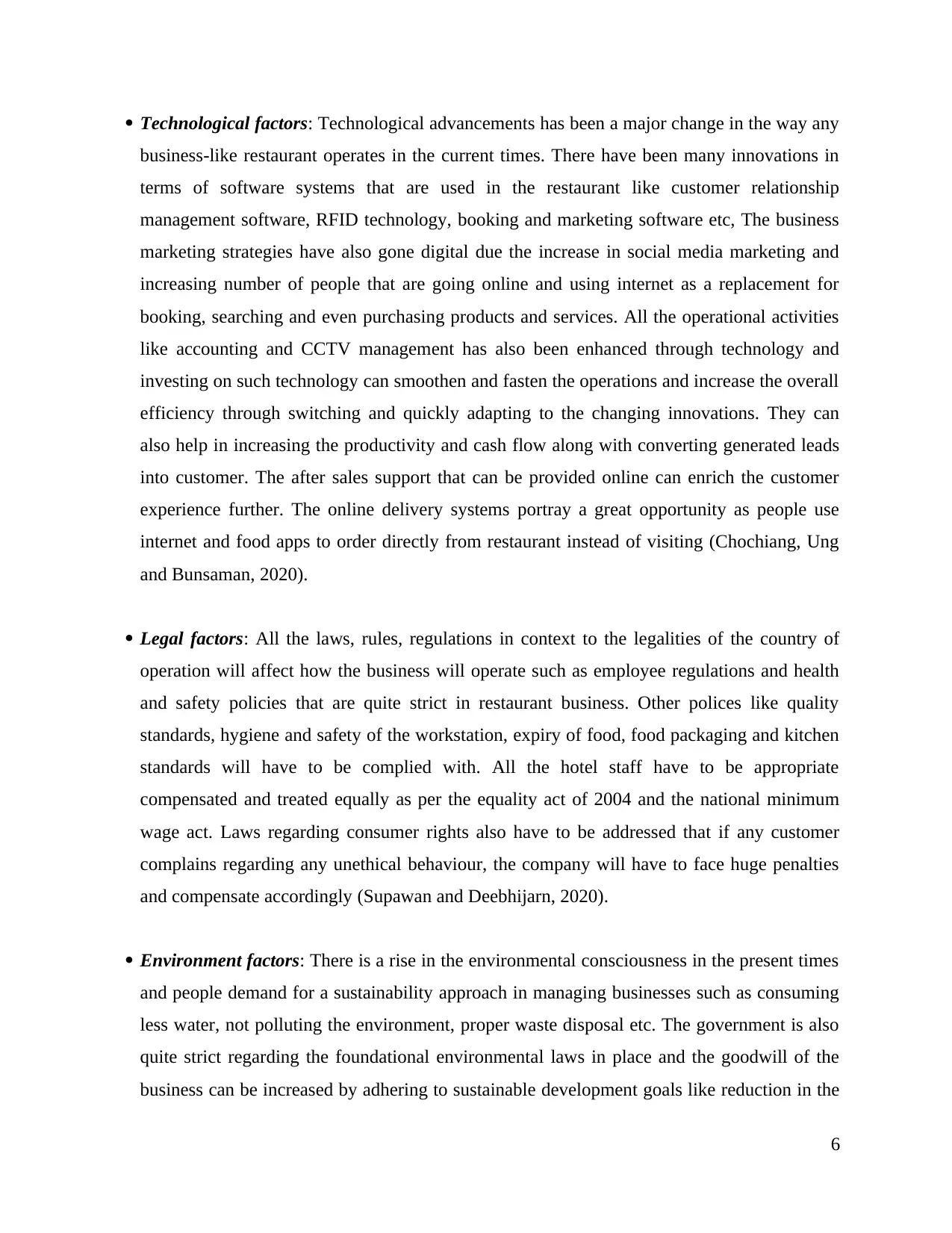
Technological factors: Technological advancements has been a major change in the way any
business-like restaurant operates in the current times. There have been many innovations in
terms of software systems that are used in the restaurant like customer relationship
management software, RFID technology, booking and marketing software etc, The business
marketing strategies have also gone digital due the increase in social media marketing and
increasing number of people that are going online and using internet as a replacement for
booking, searching and even purchasing products and services. All the operational activities
like accounting and CCTV management has also been enhanced through technology and
investing on such technology can smoothen and fasten the operations and increase the overall
efficiency through switching and quickly adapting to the changing innovations. They can
also help in increasing the productivity and cash flow along with converting generated leads
into customer. The after sales support that can be provided online can enrich the customer
experience further. The online delivery systems portray a great opportunity as people use
internet and food apps to order directly from restaurant instead of visiting (Chochiang, Ung
and Bunsaman, 2020).
Legal factors: All the laws, rules, regulations in context to the legalities of the country of
operation will affect how the business will operate such as employee regulations and health
and safety policies that are quite strict in restaurant business. Other polices like quality
standards, hygiene and safety of the workstation, expiry of food, food packaging and kitchen
standards will have to be complied with. All the hotel staff have to be appropriate
compensated and treated equally as per the equality act of 2004 and the national minimum
wage act. Laws regarding consumer rights also have to be addressed that if any customer
complains regarding any unethical behaviour, the company will have to face huge penalties
and compensate accordingly (Supawan and Deebhijarn, 2020).
Environment factors: There is a rise in the environmental consciousness in the present times
and people demand for a sustainability approach in managing businesses such as consuming
less water, not polluting the environment, proper waste disposal etc. The government is also
quite strict regarding the foundational environmental laws in place and the goodwill of the
business can be increased by adhering to sustainable development goals like reduction in the
6
business-like restaurant operates in the current times. There have been many innovations in
terms of software systems that are used in the restaurant like customer relationship
management software, RFID technology, booking and marketing software etc, The business
marketing strategies have also gone digital due the increase in social media marketing and
increasing number of people that are going online and using internet as a replacement for
booking, searching and even purchasing products and services. All the operational activities
like accounting and CCTV management has also been enhanced through technology and
investing on such technology can smoothen and fasten the operations and increase the overall
efficiency through switching and quickly adapting to the changing innovations. They can
also help in increasing the productivity and cash flow along with converting generated leads
into customer. The after sales support that can be provided online can enrich the customer
experience further. The online delivery systems portray a great opportunity as people use
internet and food apps to order directly from restaurant instead of visiting (Chochiang, Ung
and Bunsaman, 2020).
Legal factors: All the laws, rules, regulations in context to the legalities of the country of
operation will affect how the business will operate such as employee regulations and health
and safety policies that are quite strict in restaurant business. Other polices like quality
standards, hygiene and safety of the workstation, expiry of food, food packaging and kitchen
standards will have to be complied with. All the hotel staff have to be appropriate
compensated and treated equally as per the equality act of 2004 and the national minimum
wage act. Laws regarding consumer rights also have to be addressed that if any customer
complains regarding any unethical behaviour, the company will have to face huge penalties
and compensate accordingly (Supawan and Deebhijarn, 2020).
Environment factors: There is a rise in the environmental consciousness in the present times
and people demand for a sustainability approach in managing businesses such as consuming
less water, not polluting the environment, proper waste disposal etc. The government is also
quite strict regarding the foundational environmental laws in place and the goodwill of the
business can be increased by adhering to sustainable development goals like reduction in the
6
⊘ This is a preview!⊘
Do you want full access?
Subscribe today to unlock all pages.

Trusted by 1+ million students worldwide
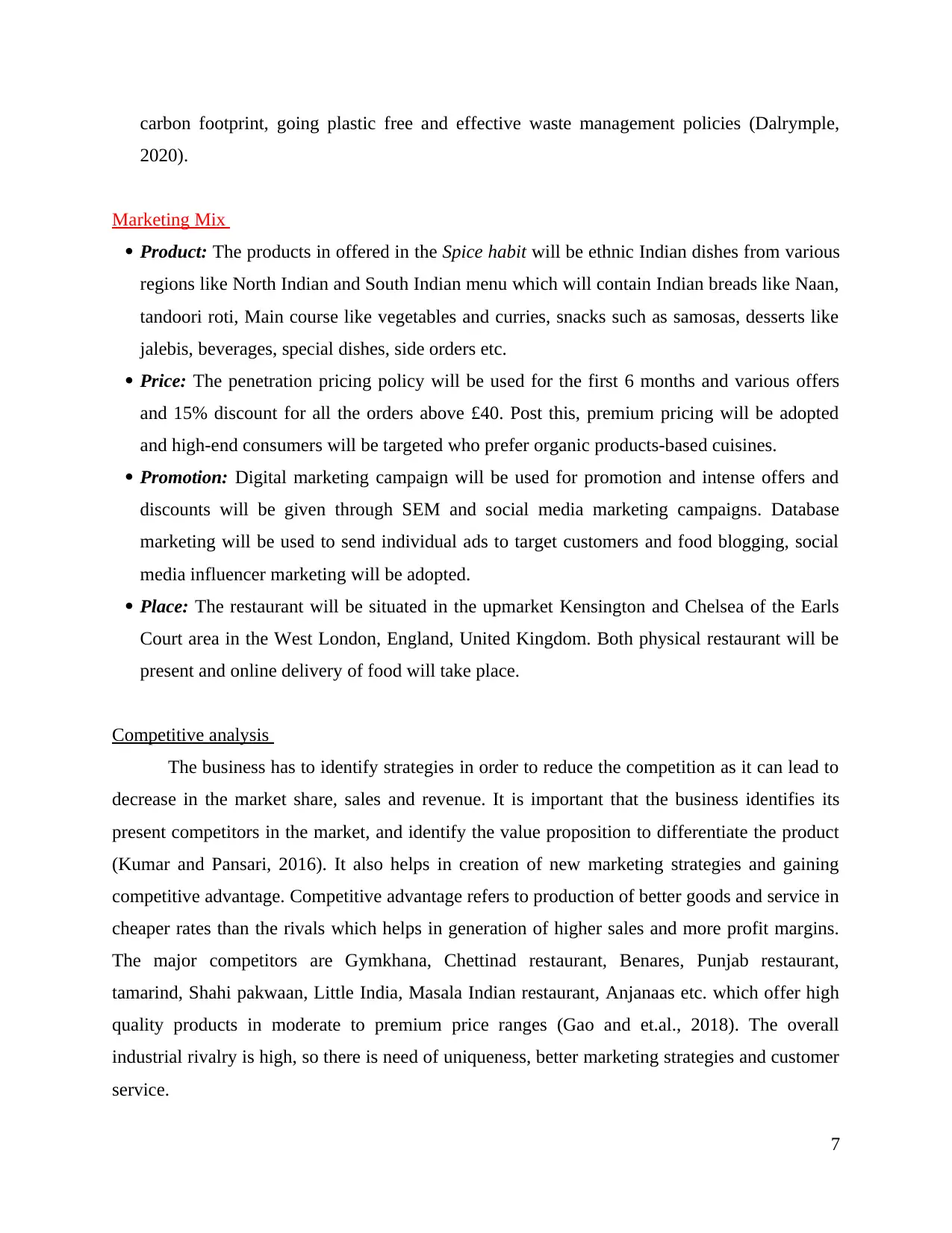
carbon footprint, going plastic free and effective waste management policies (Dalrymple,
2020).
Marketing Mix
Product: The products in offered in the Spice habit will be ethnic Indian dishes from various
regions like North Indian and South Indian menu which will contain Indian breads like Naan,
tandoori roti, Main course like vegetables and curries, snacks such as samosas, desserts like
jalebis, beverages, special dishes, side orders etc.
Price: The penetration pricing policy will be used for the first 6 months and various offers
and 15% discount for all the orders above £40. Post this, premium pricing will be adopted
and high-end consumers will be targeted who prefer organic products-based cuisines.
Promotion: Digital marketing campaign will be used for promotion and intense offers and
discounts will be given through SEM and social media marketing campaigns. Database
marketing will be used to send individual ads to target customers and food blogging, social
media influencer marketing will be adopted.
Place: The restaurant will be situated in the upmarket Kensington and Chelsea of the Earls
Court area in the West London, England, United Kingdom. Both physical restaurant will be
present and online delivery of food will take place.
Competitive analysis
The business has to identify strategies in order to reduce the competition as it can lead to
decrease in the market share, sales and revenue. It is important that the business identifies its
present competitors in the market, and identify the value proposition to differentiate the product
(Kumar and Pansari, 2016). It also helps in creation of new marketing strategies and gaining
competitive advantage. Competitive advantage refers to production of better goods and service in
cheaper rates than the rivals which helps in generation of higher sales and more profit margins.
The major competitors are Gymkhana, Chettinad restaurant, Benares, Punjab restaurant,
tamarind, Shahi pakwaan, Little India, Masala Indian restaurant, Anjanaas etc. which offer high
quality products in moderate to premium price ranges (Gao and et.al., 2018). The overall
industrial rivalry is high, so there is need of uniqueness, better marketing strategies and customer
service.
7
2020).
Marketing Mix
Product: The products in offered in the Spice habit will be ethnic Indian dishes from various
regions like North Indian and South Indian menu which will contain Indian breads like Naan,
tandoori roti, Main course like vegetables and curries, snacks such as samosas, desserts like
jalebis, beverages, special dishes, side orders etc.
Price: The penetration pricing policy will be used for the first 6 months and various offers
and 15% discount for all the orders above £40. Post this, premium pricing will be adopted
and high-end consumers will be targeted who prefer organic products-based cuisines.
Promotion: Digital marketing campaign will be used for promotion and intense offers and
discounts will be given through SEM and social media marketing campaigns. Database
marketing will be used to send individual ads to target customers and food blogging, social
media influencer marketing will be adopted.
Place: The restaurant will be situated in the upmarket Kensington and Chelsea of the Earls
Court area in the West London, England, United Kingdom. Both physical restaurant will be
present and online delivery of food will take place.
Competitive analysis
The business has to identify strategies in order to reduce the competition as it can lead to
decrease in the market share, sales and revenue. It is important that the business identifies its
present competitors in the market, and identify the value proposition to differentiate the product
(Kumar and Pansari, 2016). It also helps in creation of new marketing strategies and gaining
competitive advantage. Competitive advantage refers to production of better goods and service in
cheaper rates than the rivals which helps in generation of higher sales and more profit margins.
The major competitors are Gymkhana, Chettinad restaurant, Benares, Punjab restaurant,
tamarind, Shahi pakwaan, Little India, Masala Indian restaurant, Anjanaas etc. which offer high
quality products in moderate to premium price ranges (Gao and et.al., 2018). The overall
industrial rivalry is high, so there is need of uniqueness, better marketing strategies and customer
service.
7
Paraphrase This Document
Need a fresh take? Get an instant paraphrase of this document with our AI Paraphraser
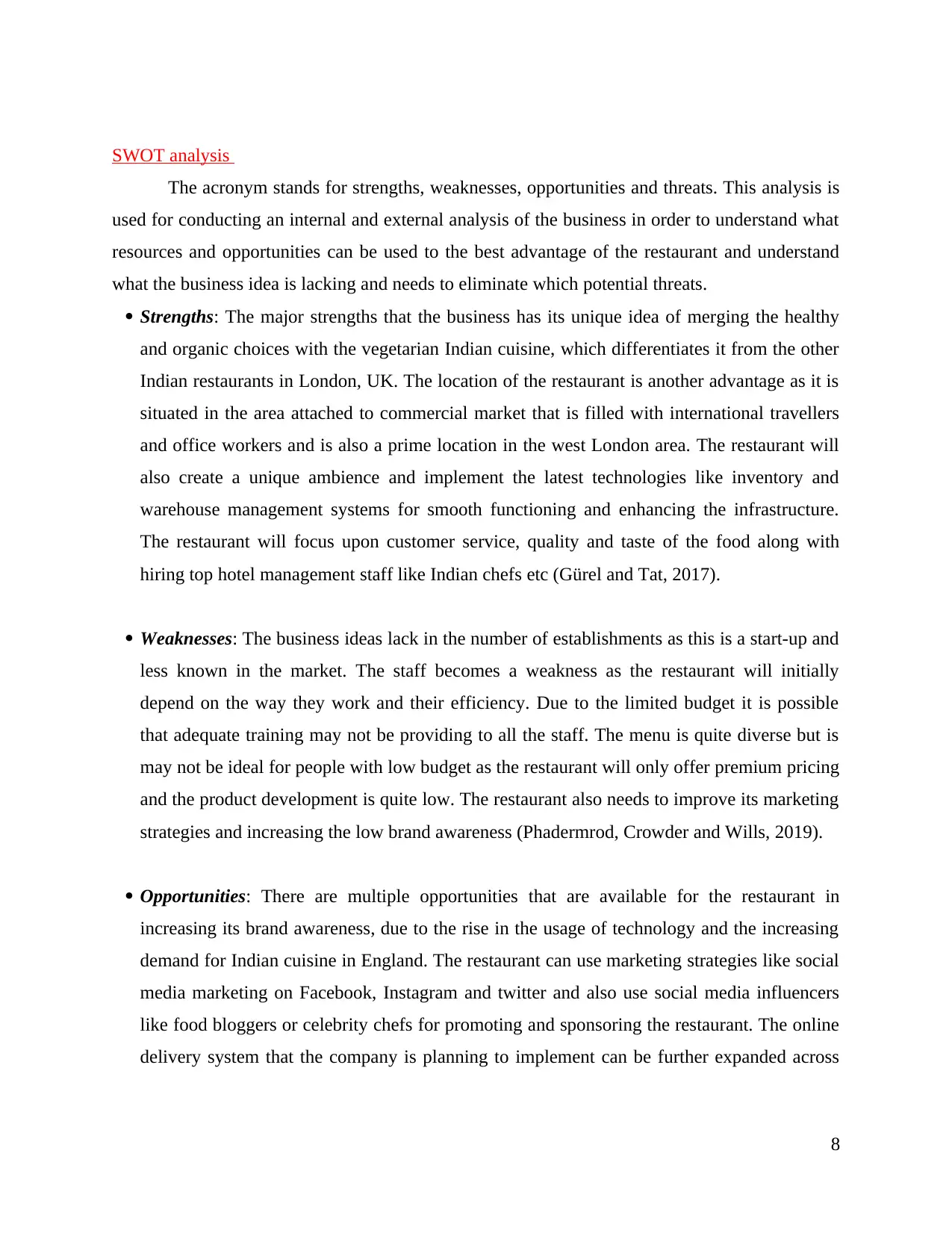
SWOT analysis
The acronym stands for strengths, weaknesses, opportunities and threats. This analysis is
used for conducting an internal and external analysis of the business in order to understand what
resources and opportunities can be used to the best advantage of the restaurant and understand
what the business idea is lacking and needs to eliminate which potential threats.
Strengths: The major strengths that the business has its unique idea of merging the healthy
and organic choices with the vegetarian Indian cuisine, which differentiates it from the other
Indian restaurants in London, UK. The location of the restaurant is another advantage as it is
situated in the area attached to commercial market that is filled with international travellers
and office workers and is also a prime location in the west London area. The restaurant will
also create a unique ambience and implement the latest technologies like inventory and
warehouse management systems for smooth functioning and enhancing the infrastructure.
The restaurant will focus upon customer service, quality and taste of the food along with
hiring top hotel management staff like Indian chefs etc (Gürel and Tat, 2017).
Weaknesses: The business ideas lack in the number of establishments as this is a start-up and
less known in the market. The staff becomes a weakness as the restaurant will initially
depend on the way they work and their efficiency. Due to the limited budget it is possible
that adequate training may not be providing to all the staff. The menu is quite diverse but is
may not be ideal for people with low budget as the restaurant will only offer premium pricing
and the product development is quite low. The restaurant also needs to improve its marketing
strategies and increasing the low brand awareness (Phadermrod, Crowder and Wills, 2019).
Opportunities: There are multiple opportunities that are available for the restaurant in
increasing its brand awareness, due to the rise in the usage of technology and the increasing
demand for Indian cuisine in England. The restaurant can use marketing strategies like social
media marketing on Facebook, Instagram and twitter and also use social media influencers
like food bloggers or celebrity chefs for promoting and sponsoring the restaurant. The online
delivery system that the company is planning to implement can be further expanded across
8
The acronym stands for strengths, weaknesses, opportunities and threats. This analysis is
used for conducting an internal and external analysis of the business in order to understand what
resources and opportunities can be used to the best advantage of the restaurant and understand
what the business idea is lacking and needs to eliminate which potential threats.
Strengths: The major strengths that the business has its unique idea of merging the healthy
and organic choices with the vegetarian Indian cuisine, which differentiates it from the other
Indian restaurants in London, UK. The location of the restaurant is another advantage as it is
situated in the area attached to commercial market that is filled with international travellers
and office workers and is also a prime location in the west London area. The restaurant will
also create a unique ambience and implement the latest technologies like inventory and
warehouse management systems for smooth functioning and enhancing the infrastructure.
The restaurant will focus upon customer service, quality and taste of the food along with
hiring top hotel management staff like Indian chefs etc (Gürel and Tat, 2017).
Weaknesses: The business ideas lack in the number of establishments as this is a start-up and
less known in the market. The staff becomes a weakness as the restaurant will initially
depend on the way they work and their efficiency. Due to the limited budget it is possible
that adequate training may not be providing to all the staff. The menu is quite diverse but is
may not be ideal for people with low budget as the restaurant will only offer premium pricing
and the product development is quite low. The restaurant also needs to improve its marketing
strategies and increasing the low brand awareness (Phadermrod, Crowder and Wills, 2019).
Opportunities: There are multiple opportunities that are available for the restaurant in
increasing its brand awareness, due to the rise in the usage of technology and the increasing
demand for Indian cuisine in England. The restaurant can use marketing strategies like social
media marketing on Facebook, Instagram and twitter and also use social media influencers
like food bloggers or celebrity chefs for promoting and sponsoring the restaurant. The online
delivery system that the company is planning to implement can be further expanded across
8
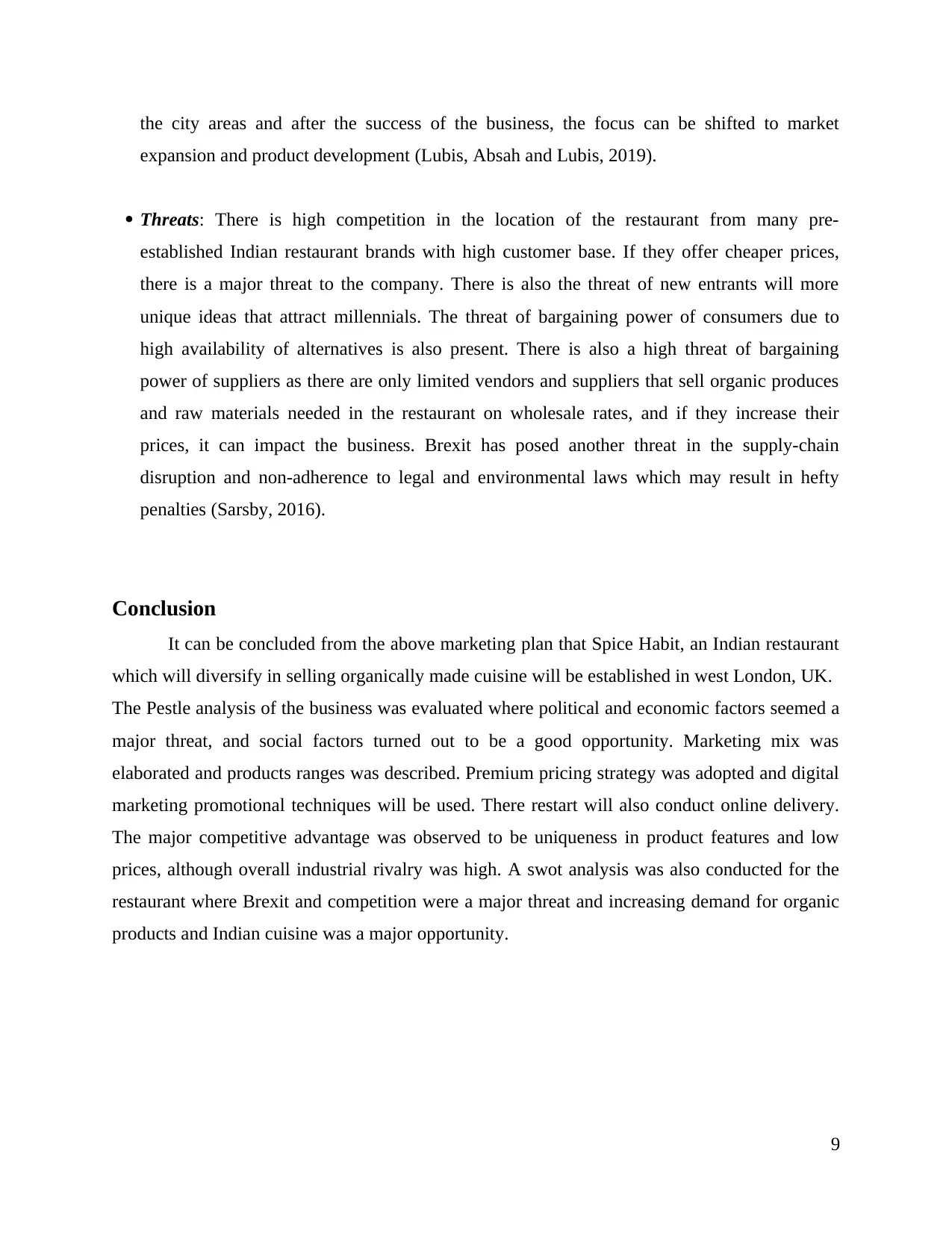
the city areas and after the success of the business, the focus can be shifted to market
expansion and product development (Lubis, Absah and Lubis, 2019).
Threats: There is high competition in the location of the restaurant from many pre-
established Indian restaurant brands with high customer base. If they offer cheaper prices,
there is a major threat to the company. There is also the threat of new entrants will more
unique ideas that attract millennials. The threat of bargaining power of consumers due to
high availability of alternatives is also present. There is also a high threat of bargaining
power of suppliers as there are only limited vendors and suppliers that sell organic produces
and raw materials needed in the restaurant on wholesale rates, and if they increase their
prices, it can impact the business. Brexit has posed another threat in the supply-chain
disruption and non-adherence to legal and environmental laws which may result in hefty
penalties (Sarsby, 2016).
Conclusion
It can be concluded from the above marketing plan that Spice Habit, an Indian restaurant
which will diversify in selling organically made cuisine will be established in west London, UK.
The Pestle analysis of the business was evaluated where political and economic factors seemed a
major threat, and social factors turned out to be a good opportunity. Marketing mix was
elaborated and products ranges was described. Premium pricing strategy was adopted and digital
marketing promotional techniques will be used. There restart will also conduct online delivery.
The major competitive advantage was observed to be uniqueness in product features and low
prices, although overall industrial rivalry was high. A swot analysis was also conducted for the
restaurant where Brexit and competition were a major threat and increasing demand for organic
products and Indian cuisine was a major opportunity.
9
expansion and product development (Lubis, Absah and Lubis, 2019).
Threats: There is high competition in the location of the restaurant from many pre-
established Indian restaurant brands with high customer base. If they offer cheaper prices,
there is a major threat to the company. There is also the threat of new entrants will more
unique ideas that attract millennials. The threat of bargaining power of consumers due to
high availability of alternatives is also present. There is also a high threat of bargaining
power of suppliers as there are only limited vendors and suppliers that sell organic produces
and raw materials needed in the restaurant on wholesale rates, and if they increase their
prices, it can impact the business. Brexit has posed another threat in the supply-chain
disruption and non-adherence to legal and environmental laws which may result in hefty
penalties (Sarsby, 2016).
Conclusion
It can be concluded from the above marketing plan that Spice Habit, an Indian restaurant
which will diversify in selling organically made cuisine will be established in west London, UK.
The Pestle analysis of the business was evaluated where political and economic factors seemed a
major threat, and social factors turned out to be a good opportunity. Marketing mix was
elaborated and products ranges was described. Premium pricing strategy was adopted and digital
marketing promotional techniques will be used. There restart will also conduct online delivery.
The major competitive advantage was observed to be uniqueness in product features and low
prices, although overall industrial rivalry was high. A swot analysis was also conducted for the
restaurant where Brexit and competition were a major threat and increasing demand for organic
products and Indian cuisine was a major opportunity.
9
⊘ This is a preview!⊘
Do you want full access?
Subscribe today to unlock all pages.

Trusted by 1+ million students worldwide
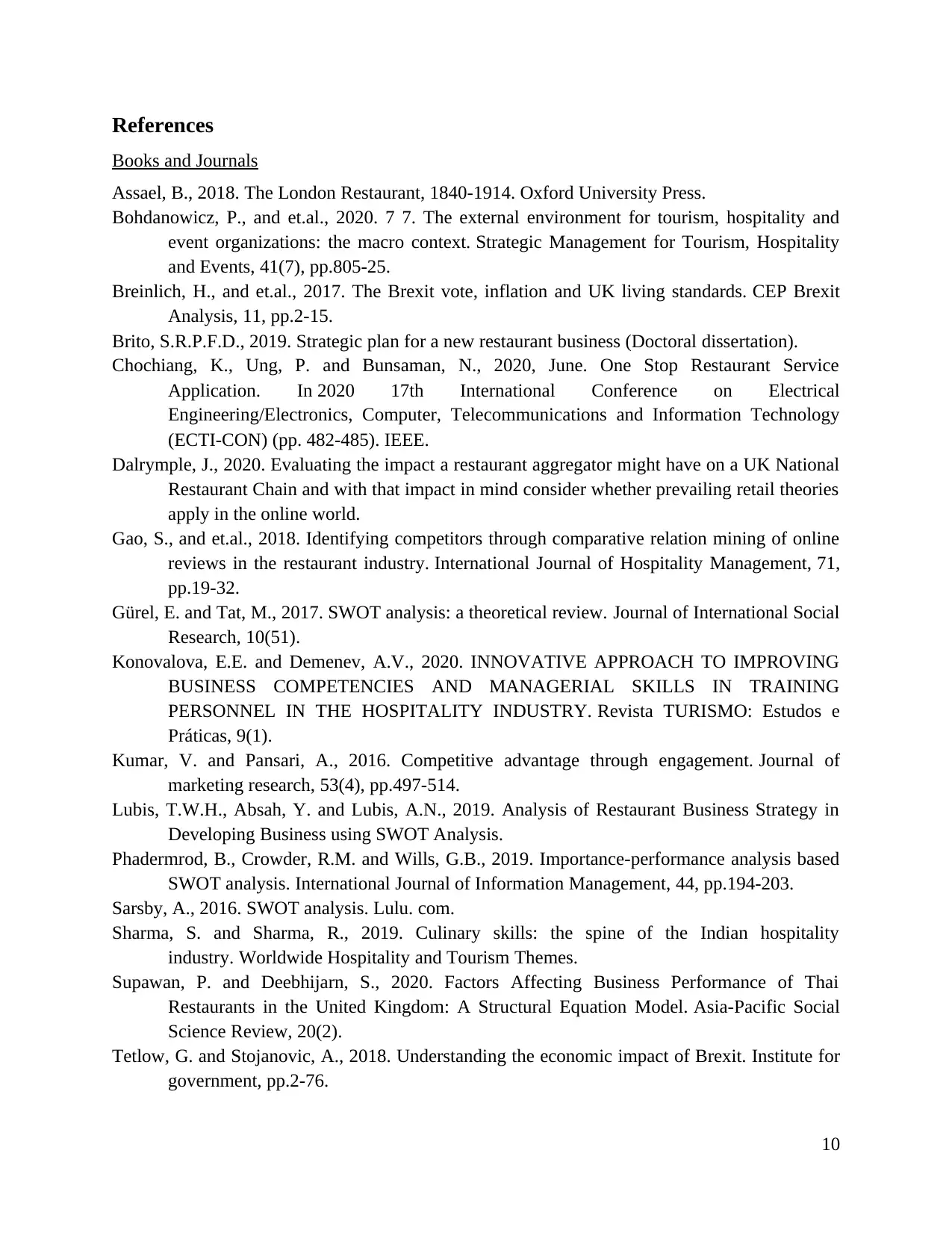
References
Books and Journals
Assael, B., 2018. The London Restaurant, 1840-1914. Oxford University Press.
Bohdanowicz, P., and et.al., 2020. 7 7. The external environment for tourism, hospitality and
event organizations: the macro context. Strategic Management for Tourism, Hospitality
and Events, 41(7), pp.805-25.
Breinlich, H., and et.al., 2017. The Brexit vote, inflation and UK living standards. CEP Brexit
Analysis, 11, pp.2-15.
Brito, S.R.P.F.D., 2019. Strategic plan for a new restaurant business (Doctoral dissertation).
Chochiang, K., Ung, P. and Bunsaman, N., 2020, June. One Stop Restaurant Service
Application. In 2020 17th International Conference on Electrical
Engineering/Electronics, Computer, Telecommunications and Information Technology
(ECTI-CON) (pp. 482-485). IEEE.
Dalrymple, J., 2020. Evaluating the impact a restaurant aggregator might have on a UK National
Restaurant Chain and with that impact in mind consider whether prevailing retail theories
apply in the online world.
Gao, S., and et.al., 2018. Identifying competitors through comparative relation mining of online
reviews in the restaurant industry. International Journal of Hospitality Management, 71,
pp.19-32.
Gürel, E. and Tat, M., 2017. SWOT analysis: a theoretical review. Journal of International Social
Research, 10(51).
Konovalova, E.E. and Demenev, A.V., 2020. INNOVATIVE APPROACH TO IMPROVING
BUSINESS COMPETENCIES AND MANAGERIAL SKILLS IN TRAINING
PERSONNEL IN THE HOSPITALITY INDUSTRY. Revista TURISMO: Estudos e
Práticas, 9(1).
Kumar, V. and Pansari, A., 2016. Competitive advantage through engagement. Journal of
marketing research, 53(4), pp.497-514.
Lubis, T.W.H., Absah, Y. and Lubis, A.N., 2019. Analysis of Restaurant Business Strategy in
Developing Business using SWOT Analysis.
Phadermrod, B., Crowder, R.M. and Wills, G.B., 2019. Importance-performance analysis based
SWOT analysis. International Journal of Information Management, 44, pp.194-203.
Sarsby, A., 2016. SWOT analysis. Lulu. com.
Sharma, S. and Sharma, R., 2019. Culinary skills: the spine of the Indian hospitality
industry. Worldwide Hospitality and Tourism Themes.
Supawan, P. and Deebhijarn, S., 2020. Factors Affecting Business Performance of Thai
Restaurants in the United Kingdom: A Structural Equation Model. Asia-Pacific Social
Science Review, 20(2).
Tetlow, G. and Stojanovic, A., 2018. Understanding the economic impact of Brexit. Institute for
government, pp.2-76.
10
Books and Journals
Assael, B., 2018. The London Restaurant, 1840-1914. Oxford University Press.
Bohdanowicz, P., and et.al., 2020. 7 7. The external environment for tourism, hospitality and
event organizations: the macro context. Strategic Management for Tourism, Hospitality
and Events, 41(7), pp.805-25.
Breinlich, H., and et.al., 2017. The Brexit vote, inflation and UK living standards. CEP Brexit
Analysis, 11, pp.2-15.
Brito, S.R.P.F.D., 2019. Strategic plan for a new restaurant business (Doctoral dissertation).
Chochiang, K., Ung, P. and Bunsaman, N., 2020, June. One Stop Restaurant Service
Application. In 2020 17th International Conference on Electrical
Engineering/Electronics, Computer, Telecommunications and Information Technology
(ECTI-CON) (pp. 482-485). IEEE.
Dalrymple, J., 2020. Evaluating the impact a restaurant aggregator might have on a UK National
Restaurant Chain and with that impact in mind consider whether prevailing retail theories
apply in the online world.
Gao, S., and et.al., 2018. Identifying competitors through comparative relation mining of online
reviews in the restaurant industry. International Journal of Hospitality Management, 71,
pp.19-32.
Gürel, E. and Tat, M., 2017. SWOT analysis: a theoretical review. Journal of International Social
Research, 10(51).
Konovalova, E.E. and Demenev, A.V., 2020. INNOVATIVE APPROACH TO IMPROVING
BUSINESS COMPETENCIES AND MANAGERIAL SKILLS IN TRAINING
PERSONNEL IN THE HOSPITALITY INDUSTRY. Revista TURISMO: Estudos e
Práticas, 9(1).
Kumar, V. and Pansari, A., 2016. Competitive advantage through engagement. Journal of
marketing research, 53(4), pp.497-514.
Lubis, T.W.H., Absah, Y. and Lubis, A.N., 2019. Analysis of Restaurant Business Strategy in
Developing Business using SWOT Analysis.
Phadermrod, B., Crowder, R.M. and Wills, G.B., 2019. Importance-performance analysis based
SWOT analysis. International Journal of Information Management, 44, pp.194-203.
Sarsby, A., 2016. SWOT analysis. Lulu. com.
Sharma, S. and Sharma, R., 2019. Culinary skills: the spine of the Indian hospitality
industry. Worldwide Hospitality and Tourism Themes.
Supawan, P. and Deebhijarn, S., 2020. Factors Affecting Business Performance of Thai
Restaurants in the United Kingdom: A Structural Equation Model. Asia-Pacific Social
Science Review, 20(2).
Tetlow, G. and Stojanovic, A., 2018. Understanding the economic impact of Brexit. Institute for
government, pp.2-76.
10
1 out of 10
Related Documents
Your All-in-One AI-Powered Toolkit for Academic Success.
+13062052269
info@desklib.com
Available 24*7 on WhatsApp / Email
![[object Object]](/_next/static/media/star-bottom.7253800d.svg)
Unlock your academic potential
Copyright © 2020–2025 A2Z Services. All Rights Reserved. Developed and managed by ZUCOL.




![Entrepreneurship Analysis: Senor Sisig Case Study, [University Name]](/_next/image/?url=https%3A%2F%2Fdesklib.com%2Fmedia%2Fimages%2Fyb%2F33be9502e3d3489b8b673b5caad4c269.jpg&w=256&q=75)